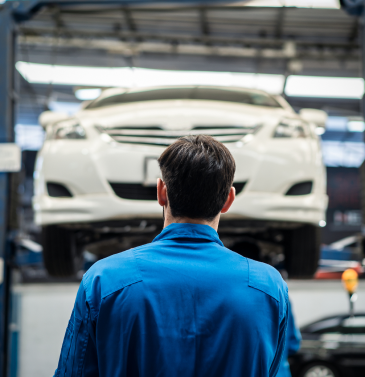Maintaining your vehicle’s brake pads is vital to extending the lifespan of your vehicle. It’s important to get your vehicle’s brakes inspected either every 10,000 miles or every time you get an oil change. Brake Works is a one-stop shop for all your brake needs, including brake pad replacements. With two convenient locations in San Antonio and convenient Saturday hours, getting your vehicle’s brakes taken care of is simple and affordable at Brake Works.
When your brakes start squeaking or deteriorating, the most common culprit is brake pad replacement. We’ll review the following on brake pad replacement:
• What are brake pads
• When to replace brake pads and longevity
• Different types of brake pads
• Ceramic vs Metallic brake pads
• The typical cost of brake pad replacement
What Are Brake Pads?
A key part of any vehicle’s brake system, the brake pads are located between your brake shoe and your brake drum. They can be easily seen on most vehicles through your wheels. The brake pads are responsible for slowing down your tires’ rotation when braking.
When Should Brake Pads Be Replaced? How Long Will They Last?
The common signs your brake pads require replacement are: squealing or screeching, metal grinding or growling, and visibly reduced brake pad thickness. Squealing noises are generally the first indicator of brake issues and are caused by a metallic shim indicator embedded in your brake pad. You can also visually inspect your brake pads through your tire spokes. It can be difficult to guesstimate, but if it looks like there is less than ¼ inch thickness in your brake pads, it’s imperative you get your vehicle inspected. Another warning sign of brake pad replacement is a deep grinding or growling sound – which means your brake calipers are making contact. At this point, it’s important to get your vehicle inspected right away, since this can quickly cause further damage to your braking system.
Once your brake pads are replaced, as long as you keep up with regular maintenance, your new brake pads should last around 40,000 miles – but it’s not totally uncommon for brake pads to last up to 80,000 miles. This longevity will depend on the weight of your car, your braking habits, and the quality and type of the pads you purchase.
What Types of Brake Pads Are There?
There are 4 types of brake pads on the market:
1. Semi-Metallic – This type of brake pad is 30% – 65% metal and are among the most durable type of brake pad. An affordable option, the semi-metallic brake pads won’t last as long as other types of brake pads. These are typically used on high performance and sports cars.
2. Ceramic – A high end option of brake pads, these are cleaner and produce less noise compared to other brake pads. These have a long mileage lifespan and outperform organic brake pads.
3. Low-Metallic, Non-Asbestos Organic – An ideal option for high temperature environments, the copper or steel used in these pads produce less heat transfer when braking. However, these tend to be noisy or let off brake dust.
4. Non-Asbestos Organic – Made from all-organic materials (fiber, glass, rubber, Kevlar), Non-Asbestos Organic brake pads are a quiet option, but typically wear down faster than other brake pads.
Ceramic vs. Metallic Brake Pads
Two of the most common types of brake pads, there are pros and cons to getting ceramic or metallic brake pads on your vehicle.
Pros of Ceramic Brake Pads – A quiet option, these create little-to-no sound when your brakes are applied. These also produce less dust and particles over time as they deteriorate. Ceramic brake pad also perform equally well in variety of temperatures and driving conditions.
Cons of Ceramic Brake Pads – The most durable option, ceramic brake pads land on the higher end of cost due to the materials they are made of. Since ceramic can’t absorb as much heat, the high temperature can create more damage for the rest of your brake system.
Pros of Metallic Brake Pads – Metallic brake pads are ideal for performance-driven drivers and luxury sportscars due to their improved braking performance. These also perform better in a wide range of temperatures and weather conditions and require less pressure to be applied to the brake pedal.
Cons of Metallic Brake Pads – Because of the materials, metallic brake pads tend to be noisier than ceramic brake pads. They are average on the pricing scale, but are not as affordable as organic brake pads.
Choosing the best type of brake pad for your vehicle is dependent on what you expect from your vehicle. From your driving style, to your climate, to the amount of mileage typically put on your vehicle, all these factors will determine whether metallic or ceramic brake pads are ideal for your brake pad replacement. Our certified technicians will be glad to assist and help you choose the best material for your brake pads.
How Much Does Brake Pad Replacement Typically Cost?
Price will vary depending on the type of brake pad you choose for your vehicle, but a total brake pad replacement can range from about $100 to a little over $300. Keep in mind, this only factors in brake pad replacement. Other brake services, such as complete brake system replacement, could be up to $1000 – so it’s important to maintain your brake pads to prevent this extra expense.
Visit Us Today!
Stop by one of our two San Antonio locations for your brake inspection, and our team of technicians will work with you to find the best service for your budget and vehicle’s needs. In addition to brake repair services, we can also address steering, and AC repair issues. Contact us today.



